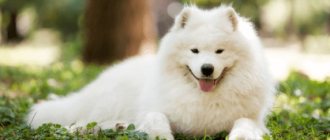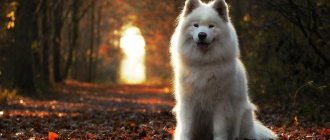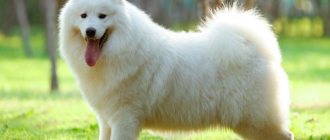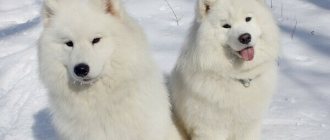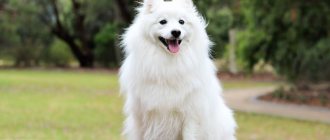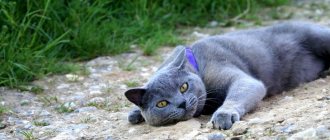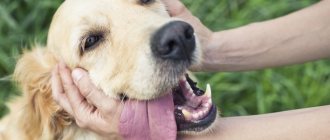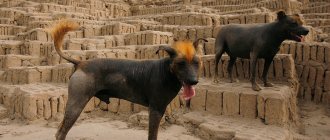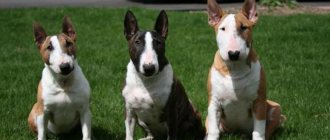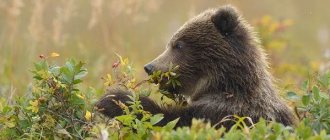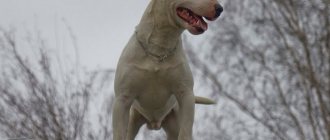The Samoyed dog is a very interesting breed. It is so unusual that even the names Samoyed Laika or Arctic Spitz used in the scientific community cannot fully reflect all its characteristic features. Magnificent thick fluffy white coat with a soft undercoat and stiffer outer hair (a typical polar explorer), slanted, very intelligent, even with some cunning eyes and a comprehensive love for all living things, which manifests itself every minute - these are the integral features of this magnificent representative of the canine family. Maximum attention, admiration and delight are guaranteed to any owner of the inimitable Samoyed!
Description of the Samoyed Laika breed
Popularity 118th place among 263 dog breeds
Lifespan:
12-15 years
Breed group:
Service
Height:
50-55 cm
Country of origin:
Siberia and northern Russia
Average price:
20-30 thousand rubles
Weight:
15-30 kg
Latest articles Cat health
Ataxia in cats: what it is, how it manifests itself and is treated 01/23/2022 151 0 0
Cat health
Leukemia, or viral leukemia in cats 01/23/2022 140 0 0
Video
* We invite you to watch a video about the Samoyed dog . In fact, in front of you is a playlist in which you can select and watch any of 20 videos about a given dog breed by simply clicking on the button in the upper right corner of the window. In addition, the material contains quite a lot of photos. By looking at them you can find out what a Samoyed dog looks like.
In this article:
|
Advantages and disadvantages
- Pros:
- good-natured and sociable, including with children;
- gets along well in an apartment;
- has good health, is strong and resilient;
- does not require special care and nutrition.
- Minuses:
- has a hard time with loneliness or resentment, as a result of which things in the apartment suffer;
- sheds heavily and requires combing;
- tries to take the place of leader, which complicates training;
- is quite expensive.
Kinds
There are two subspecies of this breed:
- Bear Samoyeds are large, stocky dogs with a short body. Designed for heavy traction work;
- The wolf Samoyed is lighter, more elongated, and more agile. They were grazing deer.
Samoyeds are not only white in color, although few people know about this. And the white color has its own characteristics: the coat should fully reflect sunlight and be illuminated by this effect. The ends of the hair should be completely translucent.
The cream color is characterized by a warm tint. Although the cream color is not very popular at shows, it is still specified in the breed standard.
The rarest color is white with biscuit spots. The Samoyed Laika dog with biscuit spots has a snow-white coat with slightly darkened pale spots along the body. Under no circumstances should the spots be yellow - this is a sign of illness and improper care.
Samoyed with biscuit spots
Key facts
You have no chance of being ignored when you go for a walk with this dog: the large snow-white dog invariably attracts attention and causes admiration.
The Samoyed is a primitive or indigenous breed, meaning that no selective breeding methods were used to breed it. This becomes clear upon a quick reading of the main characteristics of the Samoyed breed.
Samoyed huskies live in a pack according to its laws. The Samoyed is a friendly, quick-witted animal, but not prone to obedience the first time. This is where the nature of the breed comes into play.
Don't put the Samoyed on a chain! Although this breed can handle cold winter nights well, it is a companion dog, not a guard dog, and therefore does not like to be alone. The description of the Samoyed breed emphasizes that a dog will not make a watchman.
Samoyeds have the character of a loyal companion, focused on living in human society. For many centuries they have served people in the extreme north and extreme cold. A dog living with a person in such conditions has a special character. In the Arctic, they are indispensable helpers for people - they hunt large animals with them, nurse children, and protect herds of deer.
But they were not particularly used in dog sleds, since the cultural traditions of the Nenets do not allow the use of these dogs as sled dogs. There are several photos of northerners with dog sleds, but they are harnessed to other dogs. At night, Samoyeds are often allowed into the tent and cuddle with them while they sleep.
Thanks to the purity of genes, the life expectancy of Samoyeds is very long. Under appropriate conditions, snow-white beauties live 14-15 years or more.
The Samoyed Laika is an unusual breed; none of its names reflect all of its characteristics. You can immediately recognize her by her fur, easy smile, curiosity and love for people. This dog delights those around him and his owners.
Advantages and disadvantages of the breed
Each dog breed has its own advantages and disadvantages. And the Samoyed is no exception. The advantages of the breed include:
- Love for people and children;
- Loyalty of character;
- Cheerful disposition;
- Beautiful appearance;
- Get along well with other animals.
Among the disadvantages are:
- Quite a high cost of purebred puppies;
- Heavy shedding;
- Strong "talkativeness". If a dog is bored, it can howl for a long time.
In general, if we characterize the breed, then it is ideal for active families who do not welcome a domestic lifestyle. The dogs get along perfectly with any pets, small children and strangers. Their positive attitude and love for life often rubs off on their owners.
Samoyeds have all the necessary qualities to become a wonderful companion. Their loyalty, kindness, charm, grace, physical strength and endurance are admirable.
History of the origin of the Samoyed dog
For about three thousand years, Samoyed dogs have been faithful companions of people. Their appearance has remained virtually unchanged since ancient times.
The first mentions of them can be found in the Samoyed language. Some of the Samoyeds - the ancestors of the Nenets - separated from the main people and moved from the Sayan Mountains in modern Khakassia to the Arctic Circle.
The Samoyed people also bore other names - “Samoyeds”, “Samoyeds”, “Samoyeds”. Their dogs got their name from the name of the nationality. The sammie is believed to be a domesticated polar white wolf. Northern working dogs are especially similar to their ancestor.
The ancestor of modern dogs is the Aboriginal Samoyed. We owe the existence of the breed in its current form to Londoner Ernst Kilburn Scott, who brought three dogs from a trip to the Arctic - a coffee baby with the simple name Dog, a cream-colored female White Pechora and a snowy male Masti. The modern Western Samoyed dates back to these and other dogs brought by researchers a little later.
In 1909, Scott created the Farmingham kennel, and a little later a club for admirers of northern dogs arose. Around the same time, the breed standard was determined, which has remained virtually unchanged since then.
E. C. Scott informally classified all Samoyeds into three types: wolf-shaped, bear-shaped and fox-shaped. This division continues today. Their difference lies in the structure of the head.
The standard has remained virtually unchanged since its inception, last modified in 1988 by the British Kennel Club.
For 20 years, the breed won the hearts of people, and by the 30s, nurseries appeared in different parts of Europe. Thanks to them, we know the Samoyed Laika, since in our time it is almost impossible to find an aboriginal Samoyed even in the Far North, although Nenets Laikas live there, among which there are many white dogs that look like the aborigines. The number of Samoyeds in the Russian Federation today is about 2,500 individuals.
Distinctive features
Samoyeds are well-recognized dogs . According to the unofficial classification, which dates back to the beginning of the 20th century, they are conventionally divided into three subspecies. Thanks to E.K. Scott's descriptions include the following types:
- Bear-shaped;
- Fox-shaped;
- Wolf-like types.
The main difference is the shape of the head, corresponding to the name. All other exterior characteristics have the same attributes:
- The head is very powerful.
- The skull is wide (bear-shaped type) or wedge-shaped (fox-shaped and wolf-shaped types).
- The frontal part is wide, slightly convex when viewed from the front.
- The ears are small; wide, high stance; the ends are slightly rounded; the inner surface is completely covered with thick hair.
- The muzzle is deep, the narrowing towards the nose is slight.
- The nose is wedge-shaped.
- The nose is black or dark brown; in winter it can completely lose color; there must be a black border.
- The eyes are dark brown, deep set, wide set, almond shaped.
- bite .
- The teeth are strong, a complete set of 42 pieces.
- The jaws are powerful.
- The lips fit tightly, forming a recognizable “smile.”
- The neck is strong and relatively short.
- The body is stocky.
- The limbs are straight, parallel, strong muscles are clearly expressed.
- The coat is medium length, straight, very dense, shiny, double coat; there is a short, dense undercoat; noticeably fuller around the neck, shorter on the limbs; characteristic “breeches” on the hips; there is protective hair between the fingers; “ruffles” during frosty, snowy periods; has self-cleaning properties.
- The tail is fluffy and saber-shaped when moving.
- The color is pure white, minor fawn markings are allowed; the setting is high.
Appearance of a Samoyed dog
General impression
The photo of the Samoyed shows that the dog is medium in size, harmonious in build, full of dignity. It is impossible not to notice it and not pay attention to it.
Head
The head is wedge-shaped, powerfully developed with a slightly convex forehead. The ears are set at a sufficient distance. The muzzle gradually tapers away from the skull and ends in a black nose. The rim of the nose always has black pigmentation, and the nose itself can become lighter in winter (the so-called “snow nose”).
The lips also have black pigmentation, and are turned up at the corners in a “Samoyed smile.” The dental formula is complete, the teeth are closed in a scissor bite. The eyes are almond-shaped, with an oriental slant and black edging, set at a wide distance. The ears are triangular in shape, slightly rounded at the ends, mobile, set wide apart; they shouldn't hang.
Neck
The neck is strong and proudly arched.
Torso
The body is almost square, slightly elongated in length. It begins with a powerful chest, continues with a strong back with a pronounced waist, and ends with a slightly sloping croup.
Forelegs
The forelimbs are straight and even, widely spaced, parallel when viewed from the front. The paw is slightly elongated, with elongated toes, between which hair grows to protect against the cold.
Hind limbs
The hind limbs are also straight and parallel, with clear articulation angles and a developed muscle corset.
Tail
The tail is set high, very fluffy and long. When running and when excited, the tail is carried over the back or to the side, but not curled into a donut. When at rest, it hangs relaxed, reaching to the hock joints.
Movements
All the power and tirelessness of the Samoyed is visible in movement. The hind legs push strongly, the front legs move with a powerful swing. The step itself is long.
Wool
The coat is fluffy, the coat is “double”: the top layer is made of long and hard guard hair, and the bottom “lining” is made of short, soft undercoat, similar to fluff. A particularly thick “collar” is formed around the shoulders and neck. In males it is more pronounced than in females. On the head and front legs the hair is shorter, on the ears it grows perpendicular to the surface of the ear, and there is also hair inside the ear.
Hind legs with good feathering, forming fluffy pants. Males have coarser hair than females. The Samoyed's fur sparkles and has miraculous abilities - it fluffs up in the cold, and the stronger the frost, the fluffier the dog. In addition, she knows how to clean herself. Wool is hypoallergenic and has no characteristic odor.
Color
Samoyed colors come in several variations: snow white, cream or basic white with a few biscuit spots. In no case should the color or markings appear beige or light brown.
Dimensions
Samoyeds vary in height by gender. Males are taller than females, their height is 54-60 cm, females - 50-54 cm. The weight of a Samoyed, depending on height and gender, ranges from 20 to 30 kg.
The size of the Samoyed allows it to be kept in an apartment - but only on condition of daily long walks with increased activity.
Characteristics
The Samoyed husky in the photo is a common example of a dog's exterior. Samoyeds are very beautiful. The medium head is wedge-shaped, with a prominent forehead and a long, narrow muzzle that resembles a fox. The bite is scissor-shaped, the grip is strong, which allows the dogs to be hunters of small game.
The ears are fluffy even inside, erect. They have a triangular shape and are generally directed clearly forward, which makes the dog look attentive and focused.
A distinctive feature of dogs is their eyes. They look like black beads on a white fluffy background. The eyes look a little sly, as if slanted. This effect is achieved due to the black rim of the eyes - the mucous membrane is dark in color, and not white, like the rest of the body. Therefore, the Samoyed's gaze is always a little sly and smiling.
The average weight of a Samoyed husky is 25 kg, but males can weigh as much as 30. These are medium-sized dogs that are classified as Spitz. Height at the withers is about half a meter. The dog's body is short, with a dense, lean belly. The legs are straight, perpendicular to each other, strong and strong. Wide paws indicate that the dog walked through snowdrifts without difficulty.
Don’t be fooled by the airiness of Samoyeds—the dogs are muscular and strong. Their spine is strong, which allows them to withstand high loads. The movements of the Samoyed are light, smooth, as if floating. The fluffy tail is curled over the back.
The Samoyed's thick, fluffy coat requires careful and regular grooming.
Character of the Samoyed dog
The Samoyed is an ideal companion, calm, but not phlegmatic. Sammi's positive qualities are energy, trustfulness, and courage. Their busy mind must be constantly busy with work. One of the disadvantages of the Samoyed's character is stubbornness.
Living in difficult conditions and the need to coexist peacefully with people and other animals have made Samoyeds conflict-free dogs, so you don’t have to fear for the lives of cats, parrots and hamsters when you adopt a Samoyed husky puppy into your family. This same feature makes the Samoyed unsuitable for security and guard duty: the Samoyed will, at best, be wary of an intruder.
A cowardly or aggressive Samoyed is excluded from breeding. Although in the past people hunted shoulder to shoulder with these dogs, hunting is now not included in the list of functions of the Samoyed. But they are active and love to play. The best entertainment for Samoyeds is sled riding competitions, and children love it when dogs ride them in sleighs.
The Samoyed family is a pack for him, he builds a clear hierarchy in it. Samoyed huskies do not like to be alone, they are sociable and sociable, so this breed is unlikely to suit you if you are rarely at home. Although Samoyeds feel great outdoors in winter, it is absolutely forbidden to put him on a chain in the yard or keep him in an enclosure for a long time: it is better for the dog to live at home and closer to people.
The Samoyed is an ideal pet for a family with small children. Sammies love playing with babies. At the same time, the size of the dog is large enough, which eliminates the possibility that a child will harm the pet. A Samoyed puppy will become your little one's best friend, and an adult dog will become an attentive nanny.
Samoyeds rarely bark, but their owners often say that the dogs “talk.” They need physical exercise, so if you want to get a Samoyed, be prepared for an active pastime. If you are a homebody who prefers reading a book in the apartment instead of going for a run, consider a calmer breed.
Character and behavior
By nature, the Samoyed Laika is a friendly, cheerful, courageous dog. She is very devoted to her owner, follows him everywhere and cannot stand being alone. Some individuals sometimes show stubbornness and independence, and can run away during a walk. In this case, the owner needs to be patient with his pet.
Samoyeds are very attentive. They monitor the mood of their owner and quickly respond to changes in it. These sociable huskies quickly find a common language with the rest of the family and try to always be in the center of events.
This is interesting! The Samoyed dog has a well-developed freezing instinct. If you hug a Samoyed, for example, in a dream, he will try not to move so as not to disturb the person’s sleep.
Representatives of the breed usually behave warily with unfamiliar people, but without aggression, and can even allow themselves to be petted. Such a dog is unlikely to make a good watchman or security guard, because the ability to work in a team is inherent in it at the genetic level. The Samoyed dog has no developed hunting instinct, so they can live side by side with any pets without any problems.
You can learn more about hunting huskies in this article.
Attitude towards children
The Samoyed is considered one of the most fun sled dogs. These shaggy goodies retain their playfulness until old age and will never refuse to play, for example, with a ball. They are active and noisy, love attention, and puppies are even overly hooligan. That is why Samoyed huskies get along well with children, steadfastly withstanding their importunity. Very young children should not be allowed to play with Samoyeds, as they show their feelings towards children with excessive assertiveness.
Education and training
Samoyeds are highly trained and trainable, but historically they have been forced to make their own decisions to preserve their lives, and this independence often interferes with training. They do not like monotonous exercises: you will have to strain your imagination if you want to keep the dog’s attention for a long time during training.
The first play-based training should begin as early as possible. By this point, you must already put yourself in the place of the leader in the puppy’s hierarchy, otherwise there will be great difficulties with education.
There are certain techniques for establishing leadership in your relationship with your puppy; By following them, you will easily rise in the dog's hierarchy.
- The leader eats first. Feed your dog after you have eaten lunch.
- The leader is the first to enter and exit all doors. If the puppy climbs forward, pull him back.
- The leader is sleeping upstairs. Do not allow a dominant dog to climb onto elevated surfaces such as sofas and beds.
- The initiative for the game comes from the leader. Don't give in to your dog's requests to play, wait a while and offer the game yourself.
- If you give your dog a command, always ensure that it is executed correctly.
- Impermanence is your worst enemy. If you allow something today and prohibit it tomorrow, the dog will not react to the ban.
- If the puppy becomes impudent and snaps, press him to the floor until he is completely submissive, or, if his weight allows, you can lift him by the scruff of the neck and shake him lightly.
These rules may seem harsh, but they are necessary for raising a large dog. If a dog considers itself a leader, this is a direct path to problems. Earning authority from an adult dog is much more difficult than from a puppy.
To successfully raise and train a Samoyed, you will need patience and self-control, but the results will delight you for many years.
Mating
Bitches are mated no earlier than 18 months. If we are talking about breeding, in addition to the standard requirements for the health of the dog, an opinion on the condition of the hip joints is usually required. Considering the low prevalence of the breed, puppies born are subject to registration in one of the clubs or nurseries registered with the RKF.
Mating is possible from 11 to 14 days after the start of bleeding. It is advisable to select a male dog in advance due to the small number of individuals that are suitable for breeding.
Mating is carried out on the territory of the dog. For this purpose, it is better to involve an instructor, even if the owners have experience in carrying out this procedure. Samoyeds are very active, and the playful courtship process can last more than 10-15 minutes. Thus, the moment for mating will be missed.
Read a detailed article on the topic: “Everything you need to know about breeding dogs: appropriate age, what to do if it doesn’t work out, rules and tips.”
Health and diseases of the Samoyed dog
Possible diseases
Samoyed huskies are a healthy breed. But there are a number of possible diseases for the breed - hereditary, infectious and accidental, and the future owner should be aware of them.
- Infectious diseases. Dogs from the north are susceptible to infections, and Samoyeds are one of them. Therefore, it is necessary to vaccinate on time. Puppies receive their first vaccinations from the breeder, that is, the veterinary passport should already contain marks. The breeder or veterinarian will tell you about the further vaccination regimen. The frequency of vaccinations may vary depending on the vaccine.
- Hereditary diseases. To avoid hereditary diseases, all matings are carefully calculated, but still sores sometimes creep out. These include hip dysplasia, which manifests itself after six months. The dog gets tired quickly, does not run and becomes less energetic. Timely treatment will not get rid of the disease completely, but will give your pet many years of vigor. Another hereditary disease is the scourge of all white dogs - deafness. In the case of a Samoyed, it is quite difficult to notice it. Usually the dog does not respond to the name, does not respond to voice commands. There is no cure for deafness. Hereditary diseases also include a variety of eye diseases - cataracts, glaucoma, retinal atrophy. Some of them are treated more successfully, some are not. Be reasonable, respect the work of breeders and do not breed dogs with hereditary diseases!
- All other diseases are classified as random diseases. The most common occurrence is bloating. To avoid it, you need to monitor your pet’s diet and not feed the dog before a walk.
Treat your dog against insects in a timely manner. When bitten by a tick, carefully monitor your dog, as ticks carry such a deadly disease as piroplasmosis. There are now vaccinations against this disease.
If you see that your pet’s behavior has changed, he turns his face up from food, goes to the toilet differently - it’s better to play it safe and go to the veterinary clinic.
Reproductive health
Bitches come into heat early, between six months and a year. In the future, it repeats with regularity every 6-7 months. Males also mature before the age of one year, but it is too early to breed dogs of both sexes.
The optimal time for breeding a bitch is 18 months, given that she has passed all examinations and is completely healthy. Males can be born from 15 months.
Nicknames for Samoyed dogs for boys and girls: list
When a Samoyed puppy appears in the house, every owner thinks about what nickname to choose for this fluffy bear cub. Often the breeders themselves give the puppy a name, not the owners. In this case, the capital letter in the name is often determined, and the owners come up with the nickname themselves.
No matter how great the temptation may be to call this cute fluffy by some funny and amusing nickname, do not do it. Remember that the puppy will soon grow up and become a respectable animal, and will bear its name for the rest of its life.
Therefore, take your choice of nickname seriously, taking into account the advice of breeders:
The Arctic Spitz breed originated in the harsh northern regions. Therefore, it is customary to call such dogs by sonorous names that will remind of the glorious history of their origin:
- Snowball, Storm, Whirlwind, Leopard, Pole, Thunder, Hail, Wind, Fog, Frost, Cliff
- Avalanche, Blizzard, Dawn, Blizzard, Storm, Alaska, Thunderstorm, Snezhana, Umka
You can choose a foreign name using literary works about the inhabitants of the north and their sled dogs:
- Jack, Bart, Kai, Brian, Mart, Moren, Chuck, Phil, Firman, Pierre, Farim
- Virta, Stella, Gerda, Blenda, Briana, Helma, Ava, Tilda, Rhonda, Ursula, Frida
Nicknames for Samoyeds
After observing the puppy for some time, you can give a nickname taking into account its temperament. Males are more stubborn and restless, and nicknames that emphasize energy and perseverance are suitable for them. And Samoyed girls, as a rule, are more affectionate and friendly, but also mobile and active:
- Zorro, Excitement, Borey, Valt, Flash, Viking, Storm, Shooting Range, Rambo, Banzai, Sheriff
- Yula, Fairy, Utah, Astra, Sheela, Ista, Yalina, Bianka, Yurza
You can translate into a foreign language the words that are associated with the Samoyed dog (northern, snowy, fluffy, playful, white, warm, affectionate, hunter, shaggy, etc.), and choose the most sonorous of them for the nickname:
- Darling, Lucky, White, Light, Hunter, Ice, Nord, Snow, Frost, Host
- Moon, Faina, Smiley, Ace, Snuggy, Misty
Sometimes Samoyed dogs are called after the names of gods or heroes from ancient mythology and epics.
- Zeus, Hercules, Osiris, Hermes, Vulcan, Perseus, Ulysses, Charon
- Hera, Yuna (from Juno), Grace, Athena, Pandora
The best nicknames for Samoyeds
It is preferable to choose short, sonorous nicknames, as they are more convenient to use. At the same time, the official name can be long, but in everyday life it is shortened to one or two syllables:
- Benj (Benjamin), Mark (Markello), Ron (Ronaldo), Bart (Barten), Tim (Timur)
- Alya (Albina), Silva (Silvia), Siba (Siberia), Liz (Elizabeth)
Features of feeding and diet
When selling a puppy, the breeder will tell you how to feed, what to feed and how many times to feed the Samoyed. Initially, it is better to follow the breeder’s recommendations, and then you can decide for yourself what food to feed the dog. If you want to switch your dog to a different type of food, do not do it suddenly. You need to add a few granules of new food to the old food and gradually increase the amount. The transition takes 10-14 days.
If you choose dry food as food, purchase high-quality premium food or holistic food with a high protein content.
You can give your Samoyed fish and cottage cheese daily. It is better to give the natural part of the diet in the morning feeding.
If the food is balanced, then additional vitamin complexes are not required.
Key points in training
The trainability of Samoyed dogs is at a high level. However, their agile, sanguine nature requires the owner to have exceptional patience when training. Bearing in mind their pronounced ability for active physical activity with a high degree of intensity, it is advisable to take an obedience course at a fairly early age.
It is better to start exercises from 3 months. You should not count on quiet, calm processing of the commands “sit” or “lie down”. The charge of energy that dogs have does not allow them to quickly calm down and concentrate on passive tasks. It is recommended to start the training with running and practicing the “come to me” command. This will create the basis for long-term “cooperation” and mutual understanding.
Read about how to properly train a dog in the article: “Training a puppy: effective methods from dog handlers, learning commands at home.”
An additional challenge may be the high intelligence of Samoyeds. This problem can be easily solved if during training there is a frequent, unexpected change in activity for the dog - from passive walking to accelerated running. After alternating loads, dogs are more willing to comply with training requirements. In moments of disobedience, the owner must calmly, but persistently and consistently give orders until they are completely and correctly executed.
Rude shouts and the use of physical force will not lead to the desired result and will only increase the degree of mistrust.
As a punishment, it is acceptable to shake the dog slightly. Usually this measure is enough to pacify the “runaway” pet.
In addition, the Samoyed dog can be trained to search and guard premises. This area of training is not primary.
Care and maintenance
The luxurious white coat of a Samoyed can bring a lot of unpleasant moments if you care for it rarely and irregularly. A dog's love for brushing will make life much easier. Teach your puppy to brush himself about once a week from early childhood and accompany the process with positive reinforcement so that the puppy associates it with pleasure. A Samoyed does not require a haircut, but sometimes show dogs undergo grooming to highlight their strengths and hide body flaws.
If you are not going to show your dog, washing it a couple of times a year is enough. Exhibition specimens are washed with special shampoos before each exhibition. You can wash off dirt from your paws and belly after each walk. On particularly dirty autumn and spring days, wear a waterproof mudguard on your Samoyed to keep his coat clean.
An indispensable assistant in the care and maintenance of a Samoyed will be a compressor and a grooming table. The compressor dries the fur several times faster than a hair dryer, without drying out the skin and fur of the animal. Your back will thank you for the grooming table; Plus, it has been noticed that dogs behave more quietly on the table.
During shedding, you need to brush your long-haired Samoyed more often than usual. You can blow dry hair with a compressor - a stream of air blows out fallen hairs and dead skin particles, massages the skin, improving blood circulation.
The dog's coat perfectly regulates temperature not only in the cold, but also in the heat. Therefore, if you shave or trim your pet's thick coat, he is more likely to suffer from overheating than from being covered in fur.
Teeth are brushed once a week, ears are sometimes wiped with a dry cloth. Samoyeds' claws usually wear down on their own if you walk them enough.
Walks should be quite long, at least an hour and at least twice a day. It is better to spend this time actively and variedly - running, playing, doing a little training. A well-walked Samoyed will calmly take its place on the bedding and will not cause damage to the house.
History of the breed
Samoyeds are dogs from the far north of Russia. They were used for a wide variety of work, and therefore the dogs are universal in appearance and character. First of all, these are, of course, sled dogs, which is why Samoyeds are often called huskies.
The dogs were harnessed to light sleighs, and they carried cargo or one passenger. But in this regard, Samoyeds are not the best option, since Huskies and Malamutes are much stronger, faster and more energetic.
But the Samoyed shepherds are excellent. For centuries they grazed herds of deer, not allowing them to fight off the nomads. With a loud bark, Samoyeds warned of the approach of wolves and polar bears, so that people had time to drive the predators away from their herds and homes.
Samoyed Laika is an ancient northern breed of dog.
In addition, Samoyeds are nannies for children. Babies could be safely left in the care of dogs and not be afraid that something would happen to them. In the winter cold, dogs could warm people with their bodies - this is their unique feature. Samoyeds are one of those breeds that freeze next to a person and lie next to them until the person wakes up.
It is not surprising that the peoples of the North respected these dogs. A child born into a Nenets tribe received a Samoyed puppy as a gift and grew up with it. The Samoyed was a devoted friend to a child and a brave protector for an adult.
Samoyeds were published in 1889, when travelers from England became interested in them. The first kennel organized in Europe began to enjoy such popularity that even King Edward the Seventh became interested in the breed.
By 1950, Samoyeds had gained wild popularity in Europe, and then “captured” the United States. Oddly enough, the Samoyed Laika appeared in the Western part of Russia only in 1989 - before that, the dogs remained a northern mystery for the Russians. appeared in Russia
Interesting! The name “Samoyed” deserves a separate story. No, the dog does not eat itself at all. According to one version, Samoyed is an abbreviation for “it goes by itself,” that is, the dog can be easily harnessed to a sled, and it will carry a person home even without control. According to another version, “Samoyed” comes from the word “sami” - this is the name of the ancient northern people who were probably the first to breed these amazing dogs.
Samoyed is a smart and wise dog
Tips for choosing a puppy
Answer yourself the question, why do you want a Samoyed?
- For home, for family, for the soul, that is, a friend and companion. In this case, you can just take a healthy puppy you like.
- Samoyed for exhibitions and shows. If you are a beginner, it is better to consult with someone who understands the breed. The pedigree must be of the RKF-FCI system; it is good if the puppy has ancestors with a championship background. Often the breeder assumes the chances of the puppies, and the most promising one can be sold only on a co-ownership basis. You may still have to convince the breeder that you are worthy of buying the best puppy in the litter, and prove your readiness to pursue a dog's show career. The price of such a puppy is high.
- Working dog for participation in sledding competitions. Such a puppy must have working parents.
In addition to a set of documents, Samoyed puppies have a brand, and with the breeder you will sign a contract for the purchase and sale of the dog, and possibly a co-ownership agreement.
How to choose a puppy
Before purchasing a Samoyed, decide for what purpose you want to have this miracle of nature in your home.
There are several options.
Samoyed puppy
- Samoyed companion. A dog for a family home is selected according to its character and temperament. Puppies (even from the same litter) vary greatly in character. There are obvious leaders and quiet ones, there are inquisitive and restless ones, and there are balanced and calm ones. But a Samoyed baby should under no circumstances be aggressive or cowardly. Observe your chosen one for some time, if the breeder gives you such an opportunity. Do not hesitate to ask questions about the baby’s parents: what their character and behavioral characteristics are, how old they are, whether hereditary diseases have manifested themselves in the foreseeable past. As for gender, observations show that Samoyed boys more often show leadership qualities, independence and stubbornness, while girls will charm you with their affection and ability to subtly sense the mood of the owner.
- Samoyed champion. These are so-called show class puppies, the elite of the breed. The cost of such a dog is very high, so it is better to turn to experts for help in choosing - only they can predict with a high degree of accuracy the exhibition prospects of each puppy from the litter. Be sure to take an interest in the pedigree - it’s good if your ancestors include champion dogs. You can’t buy a show-class puppy right away. As a rule, offspring from promising Samoyed pairs are signed in advance. Take this moment into account!
- Samoyed for work. Such puppies are bought as sled dogs to participate in various sports competitions in the future. The parents of such puppies (or at least one of them) must themselves be working dogs. There are very few such pairs of northern huskies in Russia, so you can wait a very long time for a suitable baby.
A purebred Samoyed puppy must be branded. The mark is placed on the ear or groin. Check that the actual brand matches the one indicated in the metric and in the veterinary passport.
The animal's passport must contain all the information about the vaccinations performed with the signature of the doctor and the seal of the veterinary clinic; also pay attention that the page on anthelmintic procedures is completed and signed.
How much does a Samoyed dog cost?
The price of a Samoyed with documents starts from 15 thousand rubles and can reach up to hundreds depending on the blood and class of the puppy. The seller reserves show and working puppies from trusted producers who produce high-quality offspring at the stage of pregnancy of the bitch, and sometimes even before mating.
The cost of mating is approximately equal to the cost of a puppy, and if the mating involves traveling to foreign nurseries, it is even more expensive if you count travel expenses.
The high cost of a show dog is a guarantee of your solvency and the ability to pursue a dog’s career, since exhibitions and preparation for them are also expensive and take time.
You should not buy a dog “for the child”, “as a gift for the child” or because “the child really asks”; be prepared that caring for the dog will fall on you. And if you treat your dog with love, it will repay you a hundredfold.
Do you like the article? 0
Where to buy and price
Samoyed huskies can boast of high popularity. But this means that there is a high chance of stumbling upon an amateur breeder that is not able to guarantee the purity of the breed. In specialized nurseries, puppies will cost much more, but in this case you can be sure that they will sell a purebred pet with a good pedigree.
There are many Samoyed husky nurseries in Russia. There are a few worth noting:
- SNEZHNAYA RUSSIA offers purebred puppies with excellent pedigree.
- IZDOMASU in Yekaterinburg offers a wide selection of purebred puppies, as well as consultations with professionals on issues of maintenance and care.
- Serenade of the Northern Valley is a nursery in St. Petersburg.
The price for purebred Samoyed puppies ranges from 20,000-50,000 rubles. The lower the cost, the less chance of getting a purebred Samoyed husky.
The Samoyed is a loyal friend and reliable companion. Sweet appearance and good-natured smiling face will not leave anyone indifferent. It's impossible not to fall in love with this breed. Thanks to a wide list of positive qualities, these dogs are in demand in Russia.
Diet
Portion sizes for your pet depend on its age. An adult dog needs to be fed 2-3 times a day. The next feeding after breakfast is best done after an active walk. When creating a diet for your pet, it is necessary to select products so that it receives a sufficient amount of nutrients.
You can choose a balanced diet with the help of a veterinarian. You can use special dry or wet food to feed your dog. In this case, you should give preference to high-quality and reliable brands. After all, high-quality food contains an ideal set of all vitamins, minerals and other substances beneficial to the animal.
The basis of a dog’s natural diet should be lean boiled meat and porridge (rice, buckwheat). Be sure to add fermented milk products, sea fish, as well as seasonal fruits and vegetables. It is forbidden to feed the Samoyed raw meat, pork or chicken bones, eggs and chocolate. Make sure there is clean water in the bowl.
Possible health problems
Let's consider possible diseases and life expectancy of Samoyed huskies. This breed can be classified as a long-living breed. After all, if you follow the rules of nutrition and maintenance, Samoyeds can easily live more than fifteen years.
Samoyeds are naturally quite healthy. But representatives of the breed are prone to a number of diseases, namely:
- Cataract
- Pelvic joint dysplasia.
- Retinal atrophy.
- Diabetes.
- Pigmentation of the nose.
- Hearing loss.
To maintain the health of their pet, the owner must ensure regular preventive examinations by a veterinarian. Be sure to give your dog all necessary vaccinations.
Family life
The Samoyed is a great companion. Suitable for both older people and families with children. Dogs love children very much and can act as nannies.
You might like this! The American Eskimo Toy Spitz is an unrecognized beauty.
They are not fussy about their maintenance, and if you feed them dry food, there will be no health problems.
Unlike other representatives of Spitz-types, they will not be able to act as a domestic “bell” due to the fact that they are very friendly towards strangers.
